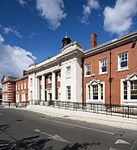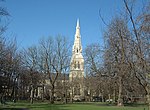Denmark Hill railway station
CamberwellCharles Henry Driver railway stationsDfT Category D stationsFormer London, Brighton and South Coast Railway stationsGrade II listed buildings in the London Borough of Southwark ... and 10 more
London stations without latest usage statistics 1415London stations without latest usage statistics 1516Rail transport stations in London fare zone 2Railway stations in Great Britain opened in 1865Railway stations in the London Borough of SouthwarkRailway stations served by London OvergroundRailway stations served by SoutheasternRecipients of Civic Trust AwardsThameslink railway stationsUse British English from August 2012

Denmark Hill railway station is in the area of Denmark Hill in south London, England, on the South London and Catford Loop lines. It is 4 miles 22 chains (6.9 km) down the line from London Victoria. It is managed by Thameslink.
Excerpt from the Wikipedia article Denmark Hill railway station (License: CC BY-SA 3.0, Authors, Images).Denmark Hill railway station
Windsor Walk, London Camberwell (London Borough of Southwark)
Geographical coordinates (GPS) Address Nearby Places Show on map
Geographical coordinates (GPS)
| Latitude | Longitude |
|---|---|
| N 51.4683 ° | E -0.0894 ° |
Address
Douglas Bennett House
Windsor Walk
SE5 8SL London, Camberwell (London Borough of Southwark)
England, United Kingdom
Open on Google Maps









